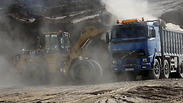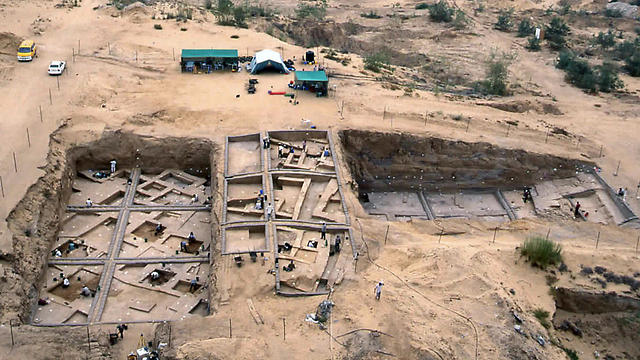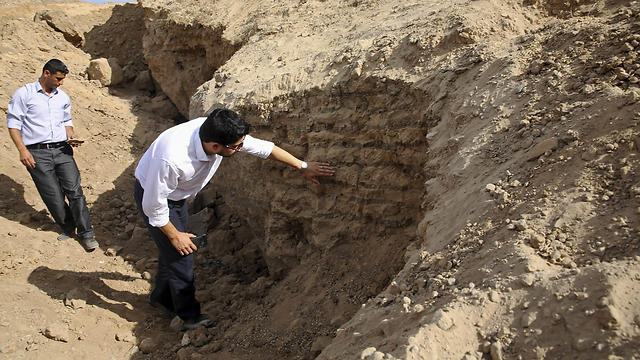
Palestinian and French archaeologists began excavating Gaza's earliest archaeological site nearly 20 years ago, unearthing what they believe is a rare 4,500-year-old Bronze Age settlement.
But over protests that grew recently, Gaza's Hamas rulers have systematically destroyed the work since seizing power a decade ago, allowing the flattening of this hill on the southern tip of Gaza City to make way for construction projects, and later military bases. In its newest project, Hamas-supported bulldozers are flattening the last remnants of excavation.
"There is a clear destruction of a very important archaeological site," said Palestinian archaeology and history professor Mouin Sadeq, who led three excavations at the site along with French archaeologist Pierre de Miroschedji after its accidental discovery in 1998. "I don't know why the destruction of the site was approved."
Tel Es-Sakan (hill of ash) was the largest Canaanite city between Palestine and Egypt, according to Sadeq. It was named after the great amount of ash found during the excavations, which suggests the settlement was burnt either naturally or in a war.
Archaeologists found the 10-hectare (25-acre) hill to be hiding a fortified settlement built centuries before pharaonic rule in Egypt, and 1,000 years before the pyramids. But the excavations stopped in 2002 due to security concerns.
When calls on Hamas to stop the recent flattening intensified last month, the nearest available expert to gain access to Gaza was Jean-Baptiste Humbert, a Jerusalem-based archaeologist at the Ecole Biblique and who had excavated other sites in Gaza.
"Today the complete southern facade of the Tel is erased," said Humbert. In previous years, faces and ramparts on other sides were also destroyed. "Now it is destroyed all around," he said.
It's among the earliest sites indicating the emergence of the "urban society" concept in the Near East, when communities were transforming from farming villages around 4,000 BC, and it was on trade routes between Egypt and the Levant, according to Humbert.
Humbert shared an aerial photo from 2000 showing patterns of walls from atop the mound. The area "was the first city of Palestine to have a city wall," he said. Now, "the field work you see in the photo is totally destroyed."

Gaza is home to numerous ancient treasures, but politics have long complicated archaeological work.
The French excavations stopped in 2002 because of a Palestinian uprising in which protesters violently clashed with Israeli troops around the nearby Netzarim settlement. Israel withdrew from Gaza in 2005. But Hamas, shunned by the West as a terrorist group, won elections and eventually drove out the Western-backed Palestinian Authority in 2007. The excavations never resumed.
Unlike more extreme Islamic groups, Hamas has not deliberately destroyed antiquities for ideological reasons. But with little open space in Gaza, a fast-growing population and an economy stifled by Israeli and Egyptian blockades, Hamas officials say they have no choice but to develop the area, making archaeology a low priority.
But the group has also seized ancient sites to build military training camps, including the 3,000-year-old Anthedon Harbor, parts of which were bulldozed in 2013.
In 2009 and 2012, the expansion of universities destroyed the western and northern facades of Tel El-Sakan. People displaced during three wars between Hamas and Israel set up temporary dwellings on the eastern side.
The southern front remained, but Hamas says it needs the land to compensate some of its senior employees, who have only received partial salaries from the cash-strapped group.
When the bulldozer work started in early August, the Hamas-run Ministry of Tourism and Antiquities appealed for help. Humbert rushed to Gaza, and with the help of colleagues from Gaza's Islamic University, he succeeded in stopping the work for two weeks while the ministry and Hamas' Land Authority worked to settle the dispute.
Jamal Abu Rida, the ministry's director of antiquities, said Tel Es-Sakan is a protected archaeological site, but that his ministry could not stop the more powerful Land Authority from destroying another 1.2 hectares (three acres).
The work resumed last week. Bulldozers loaded a truck with soil that contained fragments of jars. When the workers saw Associated Press cameras, they quickly left the scene.
Abu Rida said they recovered an early Bronze Age jar from the site during the most recent leveling. Fadel al-Outul a Gaza archaeologist, salvaged fragments that he used to reassemble two thirds of another jar. He also found a flint knife blade.
Junaid Sorosh-Wali, an official with the UN cultural agency UNESCO, inspected the damage at the site Tuesday after the bulldozers left.
What happened was "disastrous for the archaeology and cultural heritage in Palestine," he said. He said UNESCO had raised concerns with "the relevant authorities."

Amateur videos showed ramparts crumbling under the bulldozer's treads. The rampart of the southern facade was also uncovered and is slated for destruction.
Dozens of ancient sites have been found in Gaza, and excavations have revealed temples, monasteries, palaces, churches and mosques and mosaics. But most of the sites have been lost to urban sprawl and looting. UNESCO is struggling to preserve some of remaining ones.
In 2016, the remains of a Byzantine church were discovered in Gaza, but authorities are believed to have destroyed them. And in 2014, a rare Apollo statue went missing and is believed to be held by a militant group.
At St. Hilarion monastery in the central Gaza Strip, which spans from the late Roman Empire to the Islamic Umayyad period, a breach in the fence suggested looters were trying to get in. Private construction is taking place next door. Someone recently dumped brick debris in the site from over the fence.

The birthplace one of the 4th century founders of Christian monasticism still has the clear remnants of a baptism hall, a church and an atrium.
Sorosh-Wali, the UNESCO official, said it is among around a dozen locations in the West Bank and Gaza that the Palestinian Authority wants to be listed as a UNESCO "world heritage" sites.


















